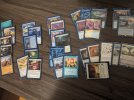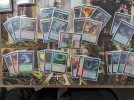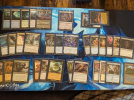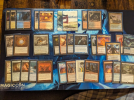Dom Harvey
Contributor
Wow they printed a lot of magic cards in the past two years
A whistlestop tour:
Lord of the Rings
Quite uneven in its power distribution; I am tempted by The One Ring but understand why others swear it off. The LOTR Commander cards were a goldmine though especially if you're a Food-motivated Human (or Human-motivated Food)
Bangers: Generous Ent et al, Relic of Sauron
Wilds of Eldraine
Hit a lot of the right flavour notes for me, loved most of this batch of Adventures; Roles were far too finicky for my taste and I wish more was done with Celebration and Bargain
Bangers: Agatha's Soul Cauldron is just incredibly cool and still at the front of my mind when I scan new creatures for colons
Lost Caverns of Ixalan
I like Explore/Maps despite it all (at the most recent PT Hall of Famer Bob Maher dipped out of retirement to sign some not-himself Dark Confidants, registered a deck with Get Lost, and had to ask what Maps were quickly followed by what Explore is). Discover did not in fact fix Cascade; Descend in all its forms was a lot of mess for little upside while Craft took DFC complexity woes to new depths
Bangers: Roaming Throne as the ur-tribal payoff I always wanted; Inti kicked off the trend of discard really mattering and is a great card in its own right; Warden of the Inner Sky is an all-timer for white one-drops in both power and nuance but not as egregious as the MH3 power couple there
Unaliving at Karlov Manor (... + Clue?)
Notionally being set on Ravnica (and putting Gravestorm on a card as a special treat for me) doesn't distract from unengaging cards but the Surveil lands alone will ensure its place in history
Bangers: Surveil lands (it's tough to imagine cracking fetchlands in Cube or Constructed without these in the mix now); Cryptic Coat makes you parse reskinned morph for the sake of one card but it's more than worth it IMO; Insidious Roots is a Hall of Fame build-around
The Clue tie-in expansion was randomly full of beauties like Carnage Interpreter but is still somewhat baffling
Outlaws of Thunder Junction
Many crimes against aesthetics and far too busy; I like plot and hats
Bangers: Cards with 'plot' on them; Nurturing Pixie was a breath of fresh air whose success was swiftly followed by every set having a cool new Nurturing Pixie
BIG SCORE
A conceptual failure but thankfully this set actually is full of great loot and I have a harder time picking bangers here than in the full-size sets: Collector's Cage is fantastic, Sandstorm Salvager is the green Blade Splicer I always wanted, Legion Extruder and Harvester of Misery are flexible and interesting, I really want Simulacrum Synthesizer to work etc
Modern Horizons 3
A real land of contrasts - MH3 wreaked (wroke? wrought?) havoc in Constructed and caused possibly irreparable harm to every format it touched while being one of the deepest wells of Cube + casual highlights in Magic history (even compared to prior MH sets). A decade after OGW I still don't get the obsession with Eldrazi and why wingdings-as-purple-mana is a permanent fixture now and the Energy experiment here proved to be more insular than modular. The Nadu debacle was an explicit confirmation that haphazard and overwhelmed Commander-first designs are a real disaster risk
Bangers: Shifting Woodland is one of my favourite cards ever; Emperor of Bones is a masterpiece; Psychic Frog is absurdly pushed but absurdly fun to play with; great stuff everywhere in the Commander decks; I didn't mean it Nadu ily
Bloomburrow
At a glance it looked like the vibes were immaculate but the cards were weak (and a tribal theme trying and succeeding at being cute but making itself inherently narrow) - in fact this is quietly one of the most powerful sets in a long time and it is responsible for most terms of engagement in Standard. This set finally dragged the spellslinger theme over the line for me and made it exciting with Stormchaser's Talent as a standout there (I'll gladly lead on that T1 or use it to loop Cryptic Command on T8) but many of the Talents are exceptional in their own ways (the Seasons are a great splashy spell cycle that brings back memories of Profane Command etc)
Bangers: Fountainport is the all-purpose Castle Ardenvale I've wanted; Keen-Eyed Curator is a home run of a design with an appealing and realistic subquest that makes you really care about the cards both players have in circulation
Duskmourn
By contrast Duskmourn was destined to catch my eye right away - a delirium theme with enchantments everywhere?! - and delivered on that promise. The Enduring and Overlord cycles are both perfect headliners for the set, there's nice structural support for the type-checking stuff at all rarities, and the Commander decks double down on all the good stuff. I was already keen to push GY stuff but now I'm ready to fully embrace it (see new post/thread!)
Bangers: Abhorrent Oculus marries so many incentives neatly - can cheat it in with reanimation/evolution or similar effects like cloak (and Oculus in turn can sneak in other stuff like the escape Titans) - while being a fine finisher to cast with backup late in your control deck
Aetherdrift
I'm running out of steam and so were they based on the muted/mixed reviews here (though I enjoyed the draft format more than I expected and didn't have the same aesthetic distaste that I shared with others for OTJ)
Bangers: Monument to Endurance
Tarkir
SAFRA DON'T READ THIS (hi hope all is great) but... I wanted more from this set. There are some neat Dragons (Shiko, Banger River Regent despite Omen's apparent similarity to Adventure setting you up for disappointment) but still so few good Dragon payoffs and people waiting more than a decade for some tricolore bangers for their favourite clan left disappointed again (you can pretend Glarb was in this set I guess?). I do like the clan mechanics but the most appealing cards with each of them are all monocolour and don't code as quintessentially Mardu or Temur etc
Bangers: Cori-Steel Cutter (just chill a bit though maybe)
Final Fantasy
As a selective FF fan (loved most of the SNES/PS-era titles (except FF7 obviously), not coincidentally didn't play more after discovering Magic) who is open to UB stuff when it reads as high fantasy (rather than Uncle Ben clubbing Knuckles the Echidna with Ace's Baseball Bat), this one was a mixed bag for me - I didn't relate to a lot of the FF7/10/14 stuff that received the most attention but the rest of the games got some good representation. FF dodged the LOTR issue of the named characters all being weak (compared to a ragtag bunch of orcs) but in part because the overall power level is low. I love the Saga designs and the Saga subtheme piqued my interest; Yuna may be the push I need to give Replenish stuff one more heave
Bangers: Vivi is flavourful + broken + very fun to play + just a lil' guy
Edge of Eternities
So far I love warp and some of the land-themed stuff and this feels more like 'a Magic set' (cowboys not allowed) than I feared so fingers crossed
Bangers: All the rares with warp
A whistlestop tour:
Lord of the Rings
Quite uneven in its power distribution; I am tempted by The One Ring but understand why others swear it off. The LOTR Commander cards were a goldmine though especially if you're a Food-motivated Human (or Human-motivated Food)
Bangers: Generous Ent et al, Relic of Sauron
Wilds of Eldraine
Hit a lot of the right flavour notes for me, loved most of this batch of Adventures; Roles were far too finicky for my taste and I wish more was done with Celebration and Bargain
Bangers: Agatha's Soul Cauldron is just incredibly cool and still at the front of my mind when I scan new creatures for colons
Lost Caverns of Ixalan
I like Explore/Maps despite it all (at the most recent PT Hall of Famer Bob Maher dipped out of retirement to sign some not-himself Dark Confidants, registered a deck with Get Lost, and had to ask what Maps were quickly followed by what Explore is). Discover did not in fact fix Cascade; Descend in all its forms was a lot of mess for little upside while Craft took DFC complexity woes to new depths
Bangers: Roaming Throne as the ur-tribal payoff I always wanted; Inti kicked off the trend of discard really mattering and is a great card in its own right; Warden of the Inner Sky is an all-timer for white one-drops in both power and nuance but not as egregious as the MH3 power couple there
Unaliving at Karlov Manor (... + Clue?)
Notionally being set on Ravnica (and putting Gravestorm on a card as a special treat for me) doesn't distract from unengaging cards but the Surveil lands alone will ensure its place in history
Bangers: Surveil lands (it's tough to imagine cracking fetchlands in Cube or Constructed without these in the mix now); Cryptic Coat makes you parse reskinned morph for the sake of one card but it's more than worth it IMO; Insidious Roots is a Hall of Fame build-around
The Clue tie-in expansion was randomly full of beauties like Carnage Interpreter but is still somewhat baffling
Outlaws of Thunder Junction
Many crimes against aesthetics and far too busy; I like plot and hats
Bangers: Cards with 'plot' on them; Nurturing Pixie was a breath of fresh air whose success was swiftly followed by every set having a cool new Nurturing Pixie
BIG SCORE
A conceptual failure but thankfully this set actually is full of great loot and I have a harder time picking bangers here than in the full-size sets: Collector's Cage is fantastic, Sandstorm Salvager is the green Blade Splicer I always wanted, Legion Extruder and Harvester of Misery are flexible and interesting, I really want Simulacrum Synthesizer to work etc
Modern Horizons 3
A real land of contrasts - MH3 wreaked (wroke? wrought?) havoc in Constructed and caused possibly irreparable harm to every format it touched while being one of the deepest wells of Cube + casual highlights in Magic history (even compared to prior MH sets). A decade after OGW I still don't get the obsession with Eldrazi and why wingdings-as-purple-mana is a permanent fixture now and the Energy experiment here proved to be more insular than modular. The Nadu debacle was an explicit confirmation that haphazard and overwhelmed Commander-first designs are a real disaster risk
Bangers: Shifting Woodland is one of my favourite cards ever; Emperor of Bones is a masterpiece; Psychic Frog is absurdly pushed but absurdly fun to play with; great stuff everywhere in the Commander decks; I didn't mean it Nadu ily
Bloomburrow
At a glance it looked like the vibes were immaculate but the cards were weak (and a tribal theme trying and succeeding at being cute but making itself inherently narrow) - in fact this is quietly one of the most powerful sets in a long time and it is responsible for most terms of engagement in Standard. This set finally dragged the spellslinger theme over the line for me and made it exciting with Stormchaser's Talent as a standout there (I'll gladly lead on that T1 or use it to loop Cryptic Command on T8) but many of the Talents are exceptional in their own ways (the Seasons are a great splashy spell cycle that brings back memories of Profane Command etc)
Bangers: Fountainport is the all-purpose Castle Ardenvale I've wanted; Keen-Eyed Curator is a home run of a design with an appealing and realistic subquest that makes you really care about the cards both players have in circulation
Duskmourn
By contrast Duskmourn was destined to catch my eye right away - a delirium theme with enchantments everywhere?! - and delivered on that promise. The Enduring and Overlord cycles are both perfect headliners for the set, there's nice structural support for the type-checking stuff at all rarities, and the Commander decks double down on all the good stuff. I was already keen to push GY stuff but now I'm ready to fully embrace it (see new post/thread!)
Bangers: Abhorrent Oculus marries so many incentives neatly - can cheat it in with reanimation/evolution or similar effects like cloak (and Oculus in turn can sneak in other stuff like the escape Titans) - while being a fine finisher to cast with backup late in your control deck
Aetherdrift
I'm running out of steam and so were they based on the muted/mixed reviews here (though I enjoyed the draft format more than I expected and didn't have the same aesthetic distaste that I shared with others for OTJ)
Bangers: Monument to Endurance
Tarkir
SAFRA DON'T READ THIS (hi hope all is great) but... I wanted more from this set. There are some neat Dragons (Shiko, Banger River Regent despite Omen's apparent similarity to Adventure setting you up for disappointment) but still so few good Dragon payoffs and people waiting more than a decade for some tricolore bangers for their favourite clan left disappointed again (you can pretend Glarb was in this set I guess?). I do like the clan mechanics but the most appealing cards with each of them are all monocolour and don't code as quintessentially Mardu or Temur etc
Bangers: Cori-Steel Cutter (just chill a bit though maybe)
Final Fantasy
As a selective FF fan (loved most of the SNES/PS-era titles (except FF7 obviously), not coincidentally didn't play more after discovering Magic) who is open to UB stuff when it reads as high fantasy (rather than Uncle Ben clubbing Knuckles the Echidna with Ace's Baseball Bat), this one was a mixed bag for me - I didn't relate to a lot of the FF7/10/14 stuff that received the most attention but the rest of the games got some good representation. FF dodged the LOTR issue of the named characters all being weak (compared to a ragtag bunch of orcs) but in part because the overall power level is low. I love the Saga designs and the Saga subtheme piqued my interest; Yuna may be the push I need to give Replenish stuff one more heave
Bangers: Vivi is flavourful + broken + very fun to play + just a lil' guy
Edge of Eternities
So far I love warp and some of the land-themed stuff and this feels more like 'a Magic set' (cowboys not allowed) than I feared so fingers crossed
Bangers: All the rares with warp




